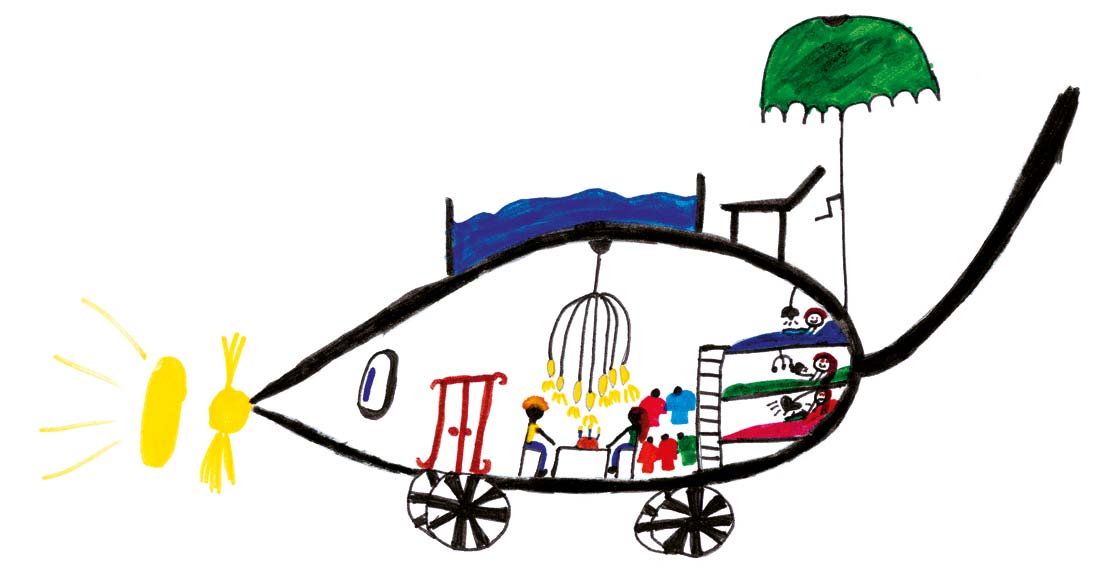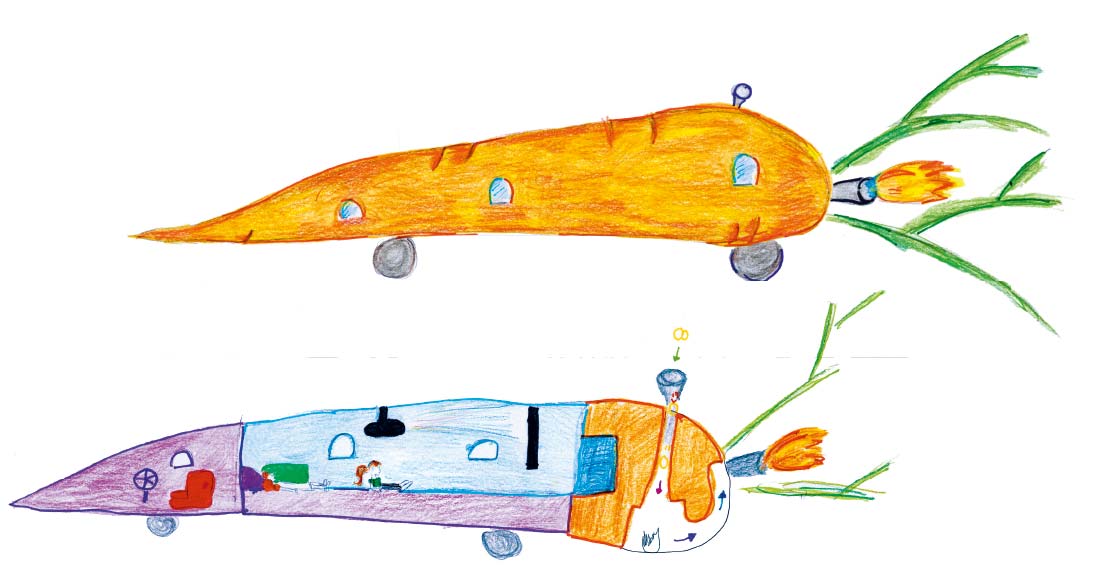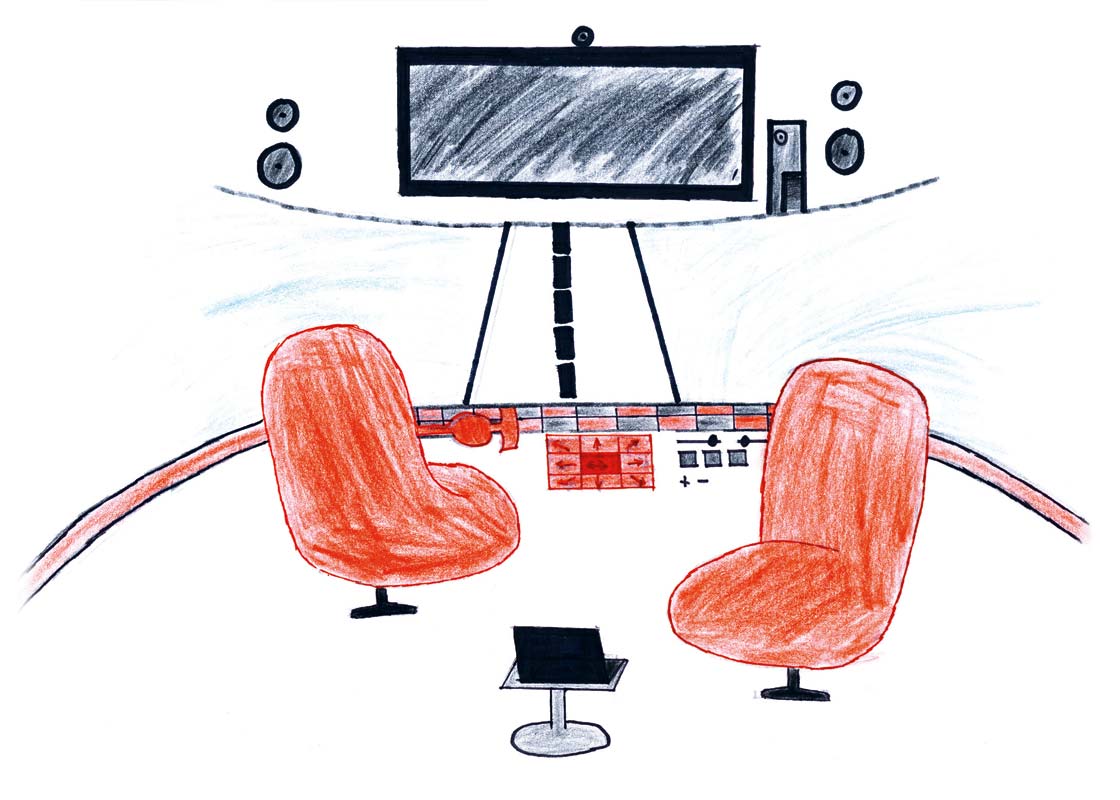Mobile dreams

Children and adults expect different things of a car. Children generally see their surroundings from the back seat. For them, the most important thing when they are traveling is good entertainment. And they have their own ideas about the shape of sustainable mobility in tomorrow’s world. Three school children drew pictures of their dream cars. ŠKODA’s Chief Designer Jozef Kabaň (43), himself the father of two children of elementary school age, took a look at the drawings.
Text: Laurin Paschek ___ Photography: Andreas Pohlmann

“I would like a car that is very small outside and very big inside. Then we wouldn’t have to spend ages looking for a parking space but there would still be lots of room for our luggage and us.”
___ Tabea, aged 8
A home from home
“For me, Tabea’s drawing conveys a warm world. The parents are sitting under a chandelier enjoying some cake, the children are lying in bunk beds and reading; there is even a pool on the roof. Inside, the car is like a big home. From the outside, the impression is different because mice are nimble, quick and small. I love this drawing because in some ways it expresses ŠKODA’s DNA: a car should be as compact as necessary on the outside while the interior should be as generous as possible with plenty of space for luggage.
Space does not have an intrinsic value, though. You have to be very conscious of how you use it, it should benefit people. That holds especially true for cars, where space is a particularly valuable commodity. I believe there is still potential for improvement. We must look at what children and adults want in terms of space. Their wishes must be our yardstick for designing the interior of our vehicles. Clever concepts allow us to create space without increasing the outer dimensions of a car.”

“Brands that want to be successful must also commit to assuming responsibility for nature. That is why our work on alternative drive systems is so important.”
___ Jozef Kabaň

“My dream car looks like a carrot. But it uses potatoes for fuel. It can drive all on its own, so you can watch movies while you’re sitting in it. Or you can have a nap on one of the beds.”
___ Sophia, aged 11
The self-driving carrot
“Sophia has put lots of detail into her drawing of her dream car. She obviously sees autonomous driving as something positive. She has also used very warm colors; the car is clearly a place for enjoyment. She has created a picture with a very strong emphasis on nature. Her drawing reflects an awareness that the environment should be treated with respect.
Brands that want to be successful must also commit to assuming responsibility for nature. That is why our work on alternative drive systems is so important. New drive concepts also offer great opportunities for advances in design. Nonetheless, I do not believe new drivetrains will produce a totally different kind of vehicle design. People are comfortable with the proportions and classic design of a car. We will continue to build cars for people, for their dreams and desires, in future, too. Our job is to fulfill these aspirations – regardless of the drivetrain technology.”

“The interior looks like a high-tech command center for the driver.”
___ Jozef Kabaň

“My dream car is connected to the Internet all the time. Everything is automatic, people can see everything that’s going on from the cockpit. Or, if you want, you can curl up in front of the car’s TV.”
___ Elias, aged 10
The virtual cockpit
“Elias’s drawing is reminiscent of the cockpit in a plane. I particularly like the perspective. The interior looks like a high-tech command center for the driver. Something else I find striking is that the monitor and the outside world have been drawn the same size. So the real and the virtual world have the same value.
Digital networking already plays a big role in our lives. We have constant access to information and knowledge. And that will intensify in future. For me it is all the more important to offer people in a car only the information that is actually relevant for them at a particular point in time. As an automaker, our starting point must be to ask ourselves what data are important for the occupants of a vehicle and what data we can disregard. The top priority must be to make sure people feel safe and secure in their vehicle rather than creating an atmosphere of stress and anxiety.”